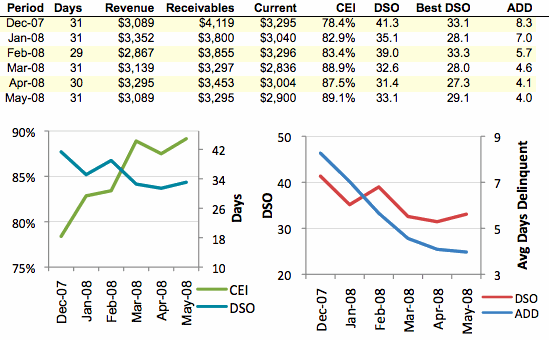
The DSO Calculation (Days Sales Outstanding)
Apr 24, 2017
DSO stands for Days Sales Outstanding It is a commonly used measure for the invoicing collection process. Investopedia defines DSO as “A measure of the average number of days that a company takes to collect revenue after a sale has been made”. If you are strictly a cash business your DSO will be 0. If you generate invoices for your customers and give them credit terms (some number of days before they are supposed to pay) then you will will have an accounts receivable balance and thus a DSO . You can use the DSO number to measure the efficiency of your collections. Since DSO is so popular you can also use it as a gauge against other companies in your industry.
Calculating your Days Sales Outstanding The calculation is as follows.
Days Sales Outstanding = Accounts Receivables \ Invoiced Sales in Period x Days in period
Example
Here is a very simple example of how to calculate DSO.
A company started June with $700 in receivables (Invoices still not paid from May and earlier).
Lets say the company had sales of $1100 in June.
The company got cash for $100 that was not cash for invoices. Some one came into their office and gave them $100 for a widget that never got invoiced.
They generated invoices with Net 30 day terms (customer has 30 days to pay) for the other $1000. These are “credit sales”. The total Credit/Invoice Sales for June will be $1000 (not $1100 since they got cash for $100 and never invoiced it, the DSO on that cash is 0). During the month they got payments on invoices of $500. So $700+$1000-$500=$1200 for their accounts receivable at the end of June. 700 that was still open + $1000 in new invoices – $500 in payments
NOTE: it does not matter what invoices the $500 got applied to or even if it gets applied for the DSO calculation. It just matters what the A/R is at the end of June.
Their accounts receivable at the end of June would be $1200. The DSO for the month of June would be $1200/$1000 X 30 (# of days in June) = 36. A 36 day average to get paid is not to bad. Generally speaking, if your DSO is under 40 (assuming Net 30 day credit terms) you are fairly efficient at collecting your money.
DSO measures efficiency not effectiveness.
In a future article we will show you the problems with DSO. Your goal is to get paid faster and there are other performance indicators that can be used, along with DSO, to get a clearer picture of your collections effectiveness.
Check out this next post in this to get a couple of alternative ways to measure your effectiveness


